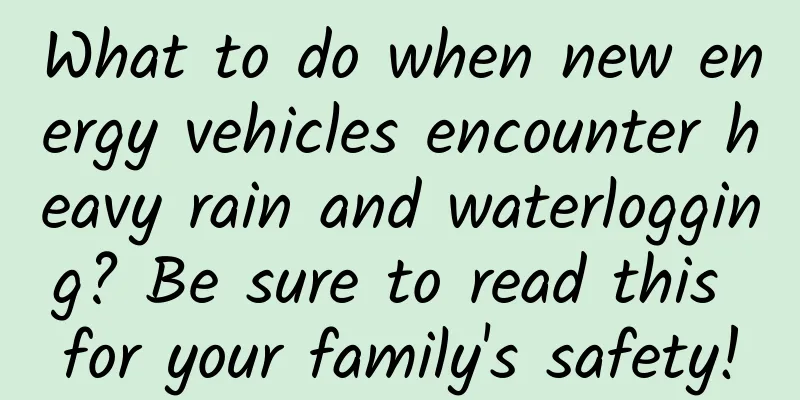What to do when new energy vehicles encounter heavy rain and waterlogging? Be sure to read this for your family's safety!

|
Recently, the country has reached the annual large-scale rainfall season. There are more and more new energy vehicles on the road. Compared with fuel vehicles , what should new energy vehicles pay attention to during heavy rain? Key points: Try to avoid going out and wading in heavy rain I once saw netizens arguing online: "Which one has better water wading ability, new energy vehicles or fuel vehicles?" Netizens who support fuel vehicles believe that new energy vehicles cannot be soaked in water, as they will leak electricity, which will not only damage the vehicle but may also injure people. Netizens who support new energy vehicles believe that the waterproof rating of new energy vehicle batteries is very high, generally reaching the IP67 level, so a little water accumulation is nothing. A fuel vehicle will break down as soon as water enters the exhaust pipe. So who is right? First of all, let me say the conclusion. New energy vehicles are also cars, not submarines. You should still try to avoid going out and wading in heavy rain. Copyright images in the gallery. Reprinting and using them may lead to copyright disputes. For traditional fuel vehicles, since the engine is divided into four strokes: intake, compression, power, and exhaust, once water enters the engine intake, the water may flow into the engine and cause it to stall. The wading depth of general sedan models is mostly between 200 and 300 mm . SUV models are taller than sedans, and the wading depth of some models can reach 300 to 400 mm. Some professional off-road vehicles (without professional wading modification) can reach a wading depth of more than 400 mm. In contrast, because the design of the "three-electric system" (battery, motor, and electronic control) pays more attention to sealing performance, the probability of water immersion in the system is very low, and the wading depth of many new energy vehicles is higher than that of traditional fuel vehicles. For example, the official wading depth of a mainstream model of a domestic brand of new energy vehicles has reached 400-450 mm. What is the concept of “ new energy vehicle battery waterproof level IP67 ” mentioned above? IP is the abbreviation of Ingress Protection Rating, which is the protection capability of an interface against solid particles and liquids. The first number represents the level of protection against solid particles , which can be understood as dust protection , ranging from 0 to 6. The larger the number, the higher the dust protection level, which means it can protect against finer dust. The second number represents the level of protection against liquids , which is commonly known as waterproofing , ranging from 0 to 8. The larger the number, the higher the waterproofing level, representing the protection from vertical water drops to underwater pressure. It can be seen that the protection level of IP67 is actually quite high. It can completely prevent the intrusion of foreign objects and dust, and ensure integrity even when immersed in water for a short time. At this time, some friends may think: "Look, the waterproof level of my car is so high, so can I be a 'white shark in the waves'?" The idea is very good, but the reality is very skinny. Driving during heavy rain, driving through flooded roads, and normal vehicle wear and tear can all make the situation very complicated. In addition, road conditions in flooded areas are unclear, and rash wading may lead to mistakenly entering deep water , resulting in more serious accidents or even casualties. The specific problems you may encounter include: 1 Water accumulation affects vision and may cause damage to the chassis and battery When water accumulates on urban roads, the roads are generally very turbid, and even clear water will seriously affect the naked eye's observation of road conditions . In this case, there are likely to be potholes, debris, etc. on the road surface. If the chassis or battery is run over or scratched, serious consequences may occur. 2 Water may enter the car through the gaps. When the vehicle's wading depth is too high, although the three-electric system is not affected and can continue to operate, water may enter the vehicle through the gaps and soak the floor mats, seats, etc. If not discovered and dealt with in time, it may cause problems such as mold, odor and accelerated wear . 3 High-tech accessories may be damaged Nowadays, many new energy vehicles use a large number of high-tech products, such as various sensors, cameras, and radars throughout the vehicle body. These accessories may also be soaked in water or damaged by water impact when driving through water . 4 "Water pools" appear inside the car, causing rust After wading, since the car body is not a regular shape, there may be "water accumulation areas" in some parts . At the same time, due to poor ventilation inside the car, the accumulated water cannot evaporate for a long time. At this time, the metal parts of the car are prone to rust, thus affecting its service life. Therefore, even if you are driving a new energy vehicle, do not enter flooded roads easily. Can new energy vehicles be charged on rainy days? According to the new national standard, the protection level of the charging gun interface before plugging in is IP54, and after plugging in is IP55. As long as you ensure that the inside of the charging gun and the charging port are dry, you can charge with confidence. However, many car owners in suburban courtyards like to use very long extension cords to charge their cars, which is very dangerous on rainy days, so be sure to pay attention. Copyright images in the gallery. Reprinting and using them may lead to copyright disputes. In addition, the charging pile may have water ingress due to loosening and deformation of the sealing rubber ring due to improper operation. In addition to rainy days, there is also a similar risk of snow falling on snowy days. Therefore, it is recommended that you follow the specifications when plugging and unplugging the charging gun. If conditions permit, try to choose a non-open-air charging pile to charge in rainy and snowy weather . New energy vehicles encounter heavy rain or flooded roads What to do Once again, I would like to emphasize that the first thing to do is to avoid driving in bad weather. If you are not going out, it is best not to go out. After all, nothing is more important than your own safety. But if you encounter bad weather while driving, here are some tips: 1 Find a high, covered spot to park You can find a high and sheltered location to park your car, and go to nearby large and sturdy buildings such as shopping malls, hotels, etc. to shelter from the rain, and continue driving after the weather improves . 2 Before entering a flooded road, observe carefully Before a vehicle enters a flooded section of road, it must conduct a thorough observation, paying attention to the depth of the water, whether the road surface is solid, and whether there are foreign objects or obstacles on the driving route . 3 Know the wading depth of your family car in advance Regarding the question of the wading depth of a family car, because the chassis height of different vehicles is different, this is not a fixed value. Generally speaking, the water depth cannot exceed the radius of the tire , that is, the water should not cover the logo in the middle of the wheel. Generally, there is no danger. On the other hand, if the water covers the logo in the middle of the wheel, it is best not to risk wading. Copyright images in the gallery. Reprinting and using them may lead to copyright disputes. 4 Keep your speed low when driving into flooded roads When driving into a flooded section of road, try to keep the speed low, not too fast, and keep the speed below 30 kilometers per hour . At the same time, according to the observation before driving, keep going straight and pass through in one go. Do not stop, change gears or turn the steering wheel suddenly during the wading process . When the car is flooded How should I be rescued? 1 Stop the car and turn off the engine If your vehicle is about to be submerged, it is best to stop and turn off the engine. Do not start a submerged vehicle, as this may cause a malfunction. 2 Observe the road conditions and escape in time Get off the vehicle promptly and walk to a safe place, but do not jump off the vehicle suddenly. Check the depth of the accumulated water and whether the road surface is flat and solid, and whether there are any foreign objects to prevent falling and injury when getting off the vehicle. 3 If the car door won't open, don't panic, try breaking the glass If the vehicle's electrical system fails due to water ingress and the door cannot be opened, do not panic . Using sharp objects or an emergency escape hammer to smash the glass will greatly increase the possibility of escape. It is best to always have an emergency escape hammer in the car . 4 Climb onto the roof for temporary shelter When water floods a car, as long as the doors and windows remain closed, it will generally not sink immediately . At this time, you need to remain calm and wait for an opportunity to escape. You can climb onto the roof of the car to take temporary shelter and wait for rescue . After the car has been flooded or What to do 1 Go to the 4S shop for inspection and repair in time After the weather improves, go to a 4S shop or auto repair shop to check the vehicle . If there is water in the vehicle, it needs to be dealt with in a timely manner. 2 Contact the insurance company as soon as possible to ensure safety If your car is flooded, while ensuring safety, notify the insurance company that insured your vehicle as soon as possible . Many insurance companies will provide free roadside assistance services with the insurance, and a professional roadside assistance company will transport the car to the repair shop. Do not move the vehicle by yourself, as this may cause secondary damage. 3 Do not force ignition when the vehicle is in water. When the vehicle is in water, do not force the ignition. Ignition in this situation may cause damage to the vehicle and the insurance company may refuse to pay the claim. References [1] Technical Scope of Operation Safety and Maintenance Assurance for Electric Passenger Vehicles (DB31T634-2012) Planning and production Author: Erzhu, a senior automobile roadside assistance practitioner Audit|Lu Kai Senior Registered Automobile Maintenance Engineer Senior Automobile Marketing Specialist Planning|Xu Lai Editor: Yang Yaping The cover image and the images in this article are from the copyright library Reprinting may lead to copyright disputes |
<<: The Giant Panda among Birds - Great Bustard
>>: Don’t bear your knee pain! Remember these 8 knee care tips
Recommend
Baidu SEM bidding price adjustment principles and techniques shared!
After Baidu launched the Fengchao system, althoug...
Do you know what the first nuclear power plant on the mainland was?
END Editor: Guru...
If you mistakenly download these ten apps, your phone may be deeply infected with viruses. Here are five warning signs:
Smartphones have become a necessary communication...
Will new media face more difficulties in 2019?
Recently, many friends have asked me: "What ...
Super complete! 9 essential tools for information flow delivery, how many have you used?
Today, the editor has compiled 9 categories of to...
Ethanol gasoline will be promoted in an orderly manner to reduce pollution and improve energy security
The State Council executive meeting held on Augus...
Why is the Mingsha Mountain in Muli, Xinjiang, known as the "world's loudest"?
Your browser does not support the video tag On th...
With an accuracy rate of over 98%, AI unlocks a new way to screen for cancer early! Will the era of early cancer treatment be here?
Cancer has always been one of the most challengin...
LeTV Motion Sense Gun: Teach you how to change your posture and masturbate in the living room
The TV game market has been tepid in recent years...
New energy vehicle patent list released: Traditional car companies are good at invention, while new forces are strong in appearance
Technology and innovation are the focus of the de...
2019 Douyin operation and promotion complete guide, recommended collection
I have learned a lot of Douyin courses recently, ...
Crow Redemption "Combo 3.0" Love Chat Tutorial Video Version + Audio Version
Course Contents: 1. "Combo 3.0" Lecture...
How to conduct product analysis based on industry and business?
1 Why? Why do I emphasize that PMs should pay att...
"Car accident during singing" is trending on the Internet! Is singing out of tune a disease? It turns out that it is really...
Recently, many music variety shows have become po...
China Passenger Car Association: Analysis of the national passenger car market in January 2022
1. Review of the national passenger car market in...









